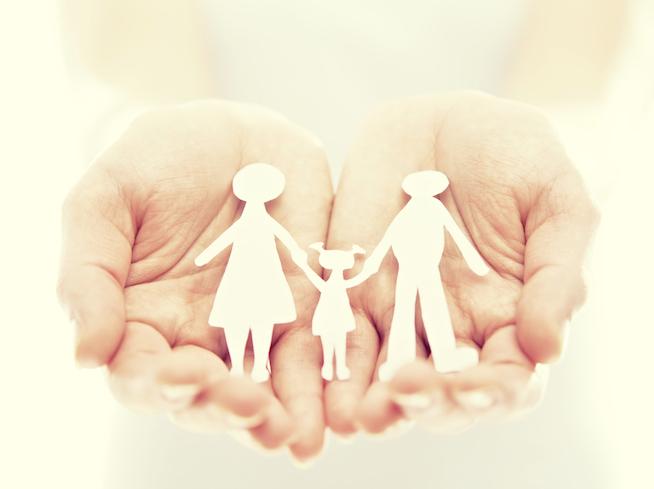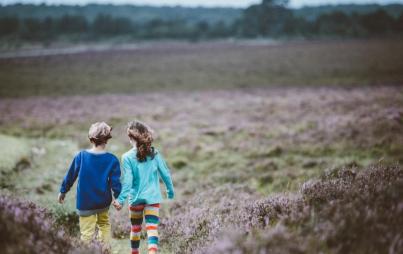
Amicable divorce.
But perhaps more than anything else, I worried about modeling an unhappy marriage to them.
I am rummaging through kitchen cabinets — scrambling to piece together a “starter cooking kit” for my eldest son, who is moving into his first apartment — when I come upon an unexpected treasure. Buried deep in a back corner behind a hodgepodge of Tupperware containers with mismatched lids is a dust-covered set of melamine cereal bowls.
Adorned with a festive pattern of brightly colored fish, the dishes have been trapped behind our spare blender for who knows how many years. But seeing them after all this time immediately sparks a surge of emotion in me; equal parts hope and sadness, followed by an overwhelming rush of gratitude.
I can remember the exact moment I bought them with a clarity that normally eludes my 46-year-old mom brain. I had been just days away from moving my two young boys out of the home they’d grown up in, and preparing to set up our belongings in what was to become our post-divorce space.
While confident in my decision to end my marriage, I was nonetheless wracked with guilt and uncertainty. This definitely wasn’t how I’d envisioned my life ending up when I was 21, pledging lifelong promises and exchanging sacred vows before hundreds of people. The most dreaded, paralyzing moment of my entire life was looking into the eyes of my 2-year-old and 5-year-old sons and attempting to wrap the concept of divorce into words they could possibly comprehend.
I worried about how they would adjust to seeing their dad every other weekend and one night a week for dinner. I worried about their ability to adapt to new surroundings. I worried that, despite so many people telling me how “resilient” children are, my own might fail to thrive. I worried about shuttling them between households. I worried about sharing holidays (“Of course Santa will know to find you in both of your homes.”). I worried about whether they would hate me one day for shattering their original family unit.
But perhaps, more than anything else, I worried about modeling an unhappy marriage to them.
And so it was that set of circumstances that had delivered me to Target’s Home section that particular day, where I was reeled in by the display of vibrant fish bowls in blissful shades of turquoise, purple, pink, and yellow. Without hesitating, I had placed six bowls with matching plates into my shopping cart, the tropical creatures representing a sea of promise, anchoring an undeniable sense of hope within me.
All I could think of right then was how unequivocally uplifting those little fish appeared. In that instant, I was consciously depending on them to make my boys’ Cheerios cheery. I would have done absolutely anything to ensure their happiness and well-being, including a seemingly insignificant investment in some cheap melamine.
It’s been more than 15 years since I placed so much hope in those brightly-colored bowls. My ex-husband and I have both been happily remarried for many years. We have stepchildren. We each have a daughter with our new spouses. We have moved on. We have blended. And most importantly, we have successfully co-parented our boys, who are nearly 17 and 20.
We did it.
Over the years, our respective families have attended sports team parties and graduation dinners together. We have sat side by side and cheered with our boys at Padres games. My ex-husband’s new wife provides notary services free of charge when we need them, and we gave her son our old family room couches when he was preparing to move out just as we purchased new furniture. When my former father-in-law passed away last year, my husband and I attended the funeral service and — despite some uncertain glances from other relatives in attendance — we sat at a reception table right next to my ex and his wife. We are all friends on Facebook.
Granted, it wasn’t always painless. It took a lot of work along the way. But the plastic fish bowls remind me how proud I can be of where we are: Proud of all the parts and pieces and personalities that had to give and take, that had to work together for the greater good of what was best for our kids, whatever that might have been at any given moment.
Which is not to say there weren't struggles. Moments of ugly name-calling. Periods when our only form of interaction was terse emails debating petty, no-win wars like whose turn it was to drop off the boys. Less-than-jolly words exchanged when the children were returned two hours late on Christmas morning. Disputes over which party was responsible for Halloween costumes, school supplies, or travel ball fees. Frustration, miscommunication, botched intentions.
Most definitely, it was a process.
But I still recall the exact moment when I knew we’d really made it. My husband was managing my younger son’s baseball team, and my ex-husband and I were serving as his assistant coaches. To top it off, we had drafted my ex’s stepson onto our team, making us the quintessential Brady Bunch of our local Little League. One night after a game, I was approached by the mom of a player on the opposite team, who I had known since our boys attended preschool together, back in my former life, before the divorce. “Wow!” she had said, embracing me. “You guys are the absolute poster family for divorce and blended families! Way to go!”
Granted, "poster family" was probably an exaggeration, but I appreciated the compliment nonetheless. Mainly because the road to achieving that status had been so hard-fought.
Our pledge to do what was “best for the kids” — a parental divorce decree that has become dangerously cliché in this day and age— didn’t mean we always agreed. Rather, it meant having to constantly compromise. It meant sometimes agreeing to switch weekends, even when it wasn’t necessarily convenient. It involved giving in. It meant we couldn’t always be right. We didn’t always get our way. We sometimes had to bite our tongues. Check our egos. Pick our battles. Roll our eyes in private, when the other wasn’t looking.
It certainly wasn’t easy.
But if we look at our boys now —kind and successful; funny and smart, happy and well-adjusted —there is no doubt whatsoever that every concession was more than worth the effort.
One of my close girlfriends is currently navigating her first year post-divorce, with two kids the exact same ages that mine were when we split — she has an almost identical custody agreement, too. I must admit, reading some of the bitter text messages between her and her ex caused memories to resurface of my own struggles to plot a positive course during those early days, when a single word or misstep had the power to rip the wound right open. “It’s going to get better,” I reassure her. “It just takes time.”
I want to promise her that everything will be OK, that her kids will thrive and flourish and escape any lasting scars, but how can I possibly predict that? Divorce is messy, co-parenting is challenging at best, and it takes far more than a set of plastic fish bowls to ensure kids come out of the process unscathed.
But the discovery of those melamine dishes is an encouraging reminder that sometimes you just need a starting point, a direction, and something to keep you — and your kids — from crying in your Cheerios.
I certainly don’t claim to have all the answers. All I know for sure is that my boys have turned out so much better than I would have ever imagined when I stood so apprehensively in Target all those years ago. And it makes me humble, relieved, and incredibly grateful.
Looking back now, embracing those fish bowls, I feel a staggering sense of peace knowing that everything worked out OK. The dishes are a powerful souvenir — they, too, were resilient.
So instead of filing the stack of fish bowls in the Goodwill bin as I originally intended, I instead slide them into the box I am assembling for my son’s new apartment. I nestle them safely inside an aluminum pot under the plates and the cups and the frying pan, their little gaping mouths still expelling tiny bright bubbles. When my son unpacks the carton and sets up his new kitchen, he’ll probably place the bowls on a shelf without a second thought. I doubt he will remember having had his maple and brown sugar oatmeal presented to him in a sea of bliss when he was 5 years old. But that’s OK.
It’s more than enough that he remembers, quite simply, that he was happy.








